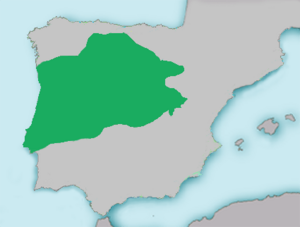Luciobarbus bocagei facts for kids
Quick facts for kids Luciobarbus bocagei |
|
|---|---|
 |
|
| Conservation status | |
| Scientific classification | |
 |
|
| Synonyms | |
|
Barbus bocagei Steindachner, 1864 (but see text) |
The Luciobarbus bocagei is a type of fish that has fins supported by bony rays. It belongs to the Cyprinidae family, which includes many well-known fish like carp and minnows. This fish is named after Jose Vicente Barboza du Bocage, a famous Portuguese zoologist (someone who studies animals) and politician.
Scientists sometimes discuss if this fish should be in the Luciobarbus group or the Barbus group. They are very similar! Other fish, like the Ebro barbel and Andalusian barbel, used to be thought of as types of L. bocagei, but now they are considered separate species.
About the Bocage's Barbel
Sometimes, the Bocage's Barbel can breed with a close relative called the Iberian Barbel (L. comizo). When two different species breed, their offspring are called hybrids. These hybrids are quite common in the middle part of the Tagus river.
It can be tricky to tell the Bocage's Barbel, the Iberian Barbel, and their hybrids apart. However, the Bocage's Barbel usually has a shorter and wider head. Also, the last fin ray on its dorsal fin (the fin on its back) has a shorter section with small bumps, but these bumps are packed closer together. Hybrids often look like a mix of both parent species.
The two barbel species also prefer different parts of the river. The Iberian Barbel likes very slow-moving or almost still water. This difference in where they live helps scientists tell them apart, even if they look similar.
Where It Lives
The Bocage's Barbel is a special fish because it is found only in the Atlantic part of the Iberian Peninsula. This means you can find it in both Portugal and Spain.
It prefers to live in the middle and lower parts of rivers where the water moves slowly. Its home range includes rivers like the Douro and Tagus. Even though it lives in a specific area, there are many of these fish. Because of this, the IUCN (a group that tracks animal populations) does not consider it an endangered species.
Life Cycle and Habits
The Bocage's Barbel mainly eats small creatures that live on the river bottom, called benthic invertebrates. It also eats detritus, which is dead plant and animal matter.
These fish lay their eggs, a process called spawning, in late spring to early summer, usually from May to June. They choose parts of the river where the water moves faster than where they normally live.
Male Bocage's Barbels become ready to breed when they are about three years old and around 7 cm (2.8 in) long. Females take much longer to mature. Some females only become ready to breed when they are eight years old and about 20 cm (7.9 in) long. This fish can live for a long time; some have been known to live up to 14 years!
See also
- Barbus haasi: Another related fish species found only in Catalonia, Spain.


